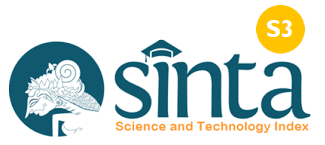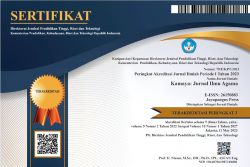Harmoni dalam Keluarga: Konstruksi Hegemoni Patriarki Melalui Sastra Piwulang Pada masa Pemerintahan Pakubuwana IX
DOI:
https://doi.org/10.37329/kamaya.v8i1.3915Keywords:
Family Harmony, Patriarchy, Sastra Piwulang, Sociology of LiteratureAbstract
“Harmony within the family” is a concept offered through sastra piwulang (didactic literature) during the reign of Pakubuwana IX at the Surakarta Palace. This concept underlies the construction of patriarchal hegemony embodied in several works of sastra piwulang, especially teachings intended for women at that time. This study focuses on analyzing sastra piwulang texts to understand how patriarchal ideology influenced social relationships and dynamics during that period, as well as how the concept of harmony was articulated through sastra piwulang. The results of the analysis show that almost all piwulang texts for women consistently carry the message of “family harmony,” which reinforces patriarchal domination in society and governance. This is reflected in the roles assigned to women, who were not entirely free to manage their existence and self-actualization. Concepts of power, control, and decision-making were held by men, resulting in gender inequality within the family. Amid this patriarchal domination, sastra piwulang functioned as a medium to articulate values that emphasized harmony within the family. The findings of this study can serve as a foundation for repositioning the role of women within Indonesian families, particularly Javanese families, in the development of gender equality programs in contemporary society.
References
Andhika, L. R. (2017). Bahaya Patronase dan Klientelisme dalam Pemilihan Kepala Desa Serentak. Kajian Menjembatani Teori dan Persoalan Masyarakat dalam Perumusan Kebijakan, 22(3), 205–220.
Athoillah, A. (2019). Patronase Politik di Keraton Yogyakarta Abad XIX. Yogyakarta: Balai Pelestarian Sejarah dan Nilai Tradisional.
Aziz, R., & Mangestuti, R. (2021). Membangun Keluarga Harmonis Melalui Cinta dan Spiritualitas pada Pasangan Suami Istri di Provinsi Jawa Timur. Jurnal Ilmu Keluarga & Konsumen, 14(2), 129–139.
Cahyati, D. D., & Lopo, Y. H. L. (2019). Daily Patronage Politics: A Village Chief’s Route to Power. PCD Journal Power Conflict Democracy, 7(2), 169–196.
Darwin, M. (2004). Gerakan Perempuan dari Masa ke Masa. Jurnal Ilmu Sosial dan Ilmu Politik, 7(3), 283–294.
Dewi, V. K., & Kasuma, G. (2014). Perempuan Masa Orde Baru: Studi Kebijakan PKK dan KB Tahun 1968–1983. Verleden: Jurnal Kesejarahan, 4(2), 157–172.
Dhona, H. R. (2020). Analisis Wacana Foucault dalam Studi Komunikasi [Using Foucauldian Discourse Analysis in Communication Studies]. Journal Communication Spectrum, 9(2), 189–208.
Freed, J. B. (1995). The Politics of Marriage. In Noble Bondsmen: Ministerial Marriages in the Archdiocese of Salzburg, 1100–1343 (pp. 181–217). Cornell University Press.
Geertz, G. (1992). Kebudayaan dan Agama. Yogyakarta: Penerbit Kanisius.
Graham-Brown, S. (1988). Images of Women: The Portrayal of Women in Photography of the Middle East 1860–1950. New York: Columbia University Press.
Harahap, E. M. (2020). Genealogi Wacana Foucault terhadap Kumpulan Cerpen “Protes” Karya Putu Wijaya. Jurnal Bahasa Indonesia Prima (JBIP), 2(1), 37–47.
Karman. (2017). Bahasa dan Kekuasaan: Instrumen Simbolik Peraih Kekuasaan Versi Bourdieu. Jurnal Studi Komunikasi dan Media, 21(2), 235–246.
Luxemburg, J. V., Bal, M., & Weststeijn, W. G. (1989). Pengantar Ilmu Sastra (D. Hartoko, Trans.). Jakarta: Gramedia.
Moertono, S. (2017). Negara dan Kekuasaan di Jawa Abad XVI–XIX. Jakarta: Kepustakaan Populer Gramedia.
Munawaroh, N. L., & Azizah, N. (2018). Disharmoni Keluarga Ditinjau dari Intensitas Komunikasi: Studi Kasus Satu Keluarga di Desa Karangpucung Kecamatan Purwokerto Selatan Kabupaten Banyumas. Komunika: Jurnal Dakwah dan Komunikasi, 12(2), 291–310.
Nugroho, Y. E. (2018). Wulang Putri: Tinjauan Filologis dan Hermeneutis Sastra Piwulang Karya Nyi Adisara. Semarang: Cipta Prima Nusantara.
Nugroho, Y. E. (2019). Represi dan Representasi Perempuan Jawa dalam Serat Piwulang. Prosiding Seminar Nasional Pascasarjana UNNES, 950–961.
Nurudin. (2003). Komunikasi Massa. Malang: Cespur.
Permanadeli, R. (2018). Wadon Representasi Sosial Perempuan Jawa di Era Modern. Yogyakarta: Pustaka Ifada.
Rokhim, M. N., Triana, D. E., Septiasih, A., Nivaga, P. S., & Janah, M. U. (2022). Metafora Konseptual Lima Jari dalam Sastra Jawa: Analisis Semantik Kognitif. Sutasoma: Jurnal Sastra Jawa, 10–21.
Sarup, M. (2003). Postrukturalisme dan Posmodernisme. Yogyakarta: Penerbit Jendela.
Siswanto, J. (2003). Metafisika Wayang: Dimensi Ontologis Wayang sebagai Simbol Kehidupan. Jurnal Filsafat, 33(1), 73–85.
Sobur, A. (2001). Analisis Teks Media: Suatu Pengantar untuk Analisis Wacana, Analisis Semiotik, dan Analisis Framing. Bandung: Remaja Rosdakarya.
Sriyadi, S., & Pramutomo, R. M. (2020). Absorpsi Tari Bedhaya Bedhah Madiun Gaya Yogyakarta di Mangkunegaran Masa Pemerintahan Mangkunegara VII. Jurnal Sejarah Citra Lekha, 5(1), 28–44.
Suhandjati, S. (2018). Kepemimpinan Laki-Laki dalam Keluarga: Implementasinya pada Masyarakat Jawa. Jurnal Theologia, 28(2), 329–350.
Suratno, P. (2016). Bahasa–Sastra sebagai Representasi Pemikiran–Kekuasaan. International Seminar Prasasti III: Current Research in Linguistics.
Sudewa, A. (2001). Sastra dan Perkembangan Politik di Jawa Abad XVIII. Humaniora, 13(3), 240–251.
Watkins, J. (2018). Marriage Diplomacy. In The Encyclopedia of Diplomacy. John Wiley & Sons Ltd.
Wibisono, J., & Iqbal, M. (2020). Maksud Politik Jahat: Benedict Anderson tentang Bahasa dan Kuasa. Jakarta: Tanda Baca.
Widoyoko, J. D. (2018). Politik, Patronase dan Pengadaan: Studi Kasus Korupsi Proyek Wisma Atlet. Integritas: Jurnal Antikorupsi, 4(2), 1–23.
Widyastuti, S. H. (2019). Nista Madya Utama, the Local Wisdom to Achieve Prosperity and Peace in the Digital Era. Incolwis 2019, Agustus 29–30.
Yap, P. M. E. H., & Tan, B. H. (2011). Families’ Experience of Harmony and Disharmony in Systemic Psychotherapy and Its Effects on Family Life. Journal of Family Therapy, 33, 302–331.
Downloads
Published
How to Cite
Issue
Section
License
Copyright (c) 2025 Kamaya: Jurnal Ilmu Agama

This work is licensed under a Creative Commons Attribution-ShareAlike 4.0 International License.
An author who publishes in the Kamaya : Jurnal Ilmu Agama agrees to the following terms:
- Author retains the copyright and grants the journal the right of first publication of the work simultaneously licensed under the Creative Commons Attribution-ShareAlike 4.0 License that allows others to share the work with an acknowledgement of the work's authorship and initial publication in this journal
- Author is able to enter into separate, additional contractual arrangements for the non-exclusive distribution of the journal's published version of the work (e.g., post it to an institutional repository or publish it in a book) with the acknowledgement of its initial publication in this journal.
- Author is permitted and encouraged to post his/her work online (e.g., in institutional repositories or on their website) prior to and during the submission process, as it can lead to productive exchanges, as well as earlier and greater citation of the published work (See The Effect of Open Access).
Read more about the Creative Commons Attribution-ShareAlike 4.0 Licence here: https://creativecommons.org/licenses/by-sa/4.0/.





